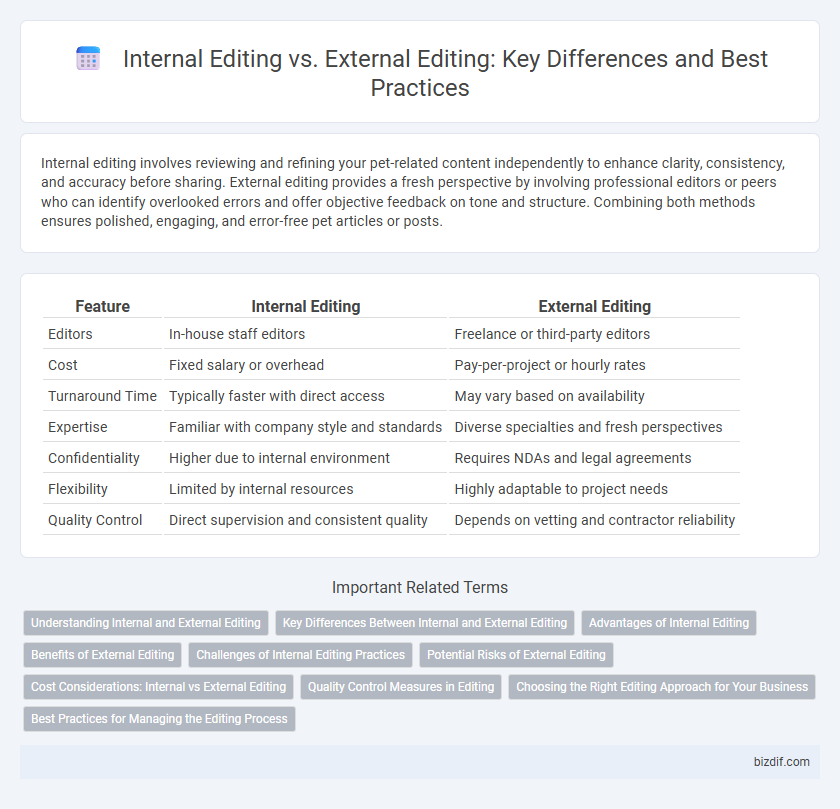Internal editing involves reviewing and refining your pet-related content independently to enhance clarity, consistency, and accuracy before sharing. External editing provides a fresh perspective by involving professional editors or peers who can identify overlooked errors and offer objective feedback on tone and structure. Combining both methods ensures polished, engaging, and error-free pet articles or posts.
Table of Comparison
| Feature | Internal Editing | External Editing |
|---|---|---|
| Editors | In-house staff editors | Freelance or third-party editors |
| Cost | Fixed salary or overhead | Pay-per-project or hourly rates |
| Turnaround Time | Typically faster with direct access | May vary based on availability |
| Expertise | Familiar with company style and standards | Diverse specialties and fresh perspectives |
| Confidentiality | Higher due to internal environment | Requires NDAs and legal agreements |
| Flexibility | Limited by internal resources | Highly adaptable to project needs |
| Quality Control | Direct supervision and consistent quality | Depends on vetting and contractor reliability |
Understanding Internal and External Editing
Internal editing involves reviewing and revising content within the organization, focusing on consistency, accuracy, and adherence to style guidelines, often conducted by writers or in-house editors. External editing is performed by professional editors outside the organization, providing objective feedback, enhancing clarity, and ensuring the content meets industry standards. Both internal and external editing play crucial roles in producing polished, error-free documents by combining insider knowledge with fresh perspectives.
Key Differences Between Internal and External Editing
Internal editing involves revising content within an organization, leveraging editors who possess in-depth knowledge of the subject matter and company style. External editing is conducted by independent professionals, offering fresh perspectives and unbiased feedback to enhance clarity, grammar, and overall quality. The key differences lie in accessibility, cost, objectivity, and the level of expertise related to the specific content or industry.
Advantages of Internal Editing
Internal editing offers a deep understanding of the project's goals and the creator's voice, leading to more cohesive and authentic content. It allows for faster turnaround times and cost savings by utilizing in-house resources familiar with the material. Maintaining control over the editing process enhances consistency and ensures alignment with organizational standards.
Benefits of External Editing
External editing offers the advantage of an unbiased perspective, which helps identify inconsistencies and errors that internal teams may overlook. Professional external editors bring specialized expertise and fresh insights, elevating the overall quality and clarity of the content. Utilizing external editing also ensures greater objectivity in tone and style, enhancing the document's appeal to broader audiences.
Challenges of Internal Editing Practices
Internal editing often faces challenges such as biased perspectives, limited expertise in specific subject matter, and constrained resources that can affect the quality and objectivity of the review process. Editors within the same organization may struggle with maintaining impartiality, leading to overlooked errors or inadequate improvements. Time constraints and overlapping responsibilities further hinder thorough internal editing practices.
Potential Risks of External Editing
External editing introduces potential risks such as confidentiality breaches, as sensitive content is exposed to third-party editors unfamiliar with internal protocols. Misalignment with the original vision or tone can occur, resulting in inconsistencies that compromise the document's integrity. Dependence on external editors may also lead to delays and increased costs compared to streamlined internal editing workflows.
Cost Considerations: Internal vs External Editing
Internal editing offers cost savings by utilizing in-house resources without additional fees, making it ideal for ongoing projects with budget constraints. External editing involves a higher upfront expense but provides access to specialized expertise and objective feedback, potentially improving overall content quality and reducing costly revisions. Organizations balance these costs by assessing project scope, desired quality level, and available internal skill sets.
Quality Control Measures in Editing
Internal editing involves in-house editors who apply rigorous quality control measures such as consistency checks, adherence to style guides, and factual verification to ensure accuracy and coherence within the document. External editing offers a fresh perspective through professional editors or specialized agencies, emphasizing critical evaluation, unbiased feedback, and compliance with industry standards to enhance overall quality. Both approaches incorporate systematic proofreading, error detection, and content refinement strategies to maintain high editorial standards.
Choosing the Right Editing Approach for Your Business
Selecting the appropriate editing approach for your business hinges on factors like budget, project scope, and desired expertise. Internal editing offers greater control and immediate feedback, benefiting teams familiar with the content, while external editing provides specialized skills and objective insights to enhance quality. Balancing these strengths ensures efficient workflow and polished final products aligned with your brand standards.
Best Practices for Managing the Editing Process
Effective management of the editing process involves establishing clear communication channels between internal editors familiar with the content and external editors who provide objective feedback. Best practices include setting defined roles and deadlines, utilizing collaborative tools for real-time updates, and implementing a standardized style guide to maintain consistency across all revisions. Prioritizing a structured workflow enhances accuracy, reduces turnaround time, and ensures the final output meets quality standards.
Internal Editing vs External Editing Infographic

 bizdif.com
bizdif.com